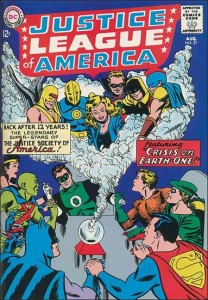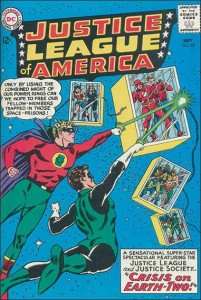
Hi, and welcome to the Ye Olde School Café fill-in week. Billy is on vacation this week, and so to be a little different I will be filling in with a DC column. There were a few things that helped me make my decision on which story to pick: The current JLA/JSA crossover in their respective books, Justice League: Crisis on Two Earths having been released to DVD earlier this year, and the fact that as a kid some of the comics I most looked forward to were the JLA/JSA summer crossovers. So we go way back to the beginning in 1963 and look at the first JLA/JSA crossover Justice League of America #21 & 22.
To set up the scene for this time period, it had been established that in the world of Barry Allen, Hal Jordan, etc, the old heroes of Jay Garrick and Alan Scott were just comic book characters. So, DC needed a way to bring back the older characters, and with Flash #123, Gardner Fox introduced the concept that there were two earths, existing in the same place, but vibrating at different speeds, and so Earth-Two was born. This proved so popular with comic fans that Fox used it again in #129, and in #137 even went as far as to feature an appearance by the Justice Society of America. At this point the time was ripe to expand the concept from The Flash to Justice League of America. Like the Flash stories, these were again written by Gardner Fox, this time with Mike Sekowsky on pencils.
The story opens in a Justice League Headquarters with the team discussing a challenge made to the team by a group calling themselves the Crime Champions, while on a very similar world the newly reformed Justice Society does the same thing. Typical of the Justice League stories of the time, the teams split into smaller groups to face each villain. On Earth-One, Atom, Aquaman, and Martian Manhunter team up against Felix Faust; Wonder Woman, Green Lantern, and Batman go after Chronos; and Superman, Green Arrow, and the Flash take on Doctor Alchemy. While on Earth-Two the Justice Society divide into teams of Flash, Atom, and Hawkman; Green Arrow and Black Canary; and Hourman and Doctor Fate.
Chapter Two continues with the smaller groups confronting the villains. We find Felix Faust attempting to rob a ship of its gold, Doctor Alchemy stealing an entire armored car, and Chronos breaking into a bank. In the course of the battle, the Flash disappears, and while in the battles themselves our heroes win in the end, the villains fade away and escape. And on Earth-Two we see events mirror what has happened on the other world, including the disappearance of Jay Garrick (The Flash). The chapter closes with the villains meeting up, and we find out how The Fiddler, Icicle, and The Wizard first discovered Earth-One by chance.
Chapter Three continues the meeting, as the villains show in flashback how Chronos, Felix Faust, and Dr. Alchemy saw them appear on Earth-One and how that led to the two groups of villains joining forces. At this point it is also revealed that the Flashes were taken out of play because they were the only ones who would recognize the villains on either Earth. With the success of their plan, the two groups then switch Earths to use their stolen money with no fear of being recognized. But instead of reveling in success, the Earth-Two villains become bored and decide to issue a challenge to the Justice League, but disguise themselves as their counterparts. In the battle that follows, the Justice League arrive to battle their foes once again, and seemingly evade their opponents’ attacks to regroup, only to find that they have been maneuvered into touching various objects, which together form the basis for a magic trap which transports the Leaguers to their own headquarters. There they find that they cannot leave their HQ, as it has been turned into a trap in itself, holding the members of the JLA. Trapped Batman devises a plan to contact the missing Flash using Merlin’s Crystal Ball, and with this they learn what has really happened and how to contact the Justice Society on Earth-Two. With the help of Dr. Fate, the two teams meet for the first time and switch worlds, with two Green Lanterns going separately to rescue the still trapped Flashes.
Issue #22 begins with the Justice Society taking on the Crime Champions on Earth-One. Breaking into smaller groups, Hourman and Atom take down the Fiddler; Dr. Fate takes out the Icicle; while Hawkman and Black Canary defeat The Wizard.
Chapter Two brings us to the Justice League and Earth-Two, where we find teams consisting of Martian Manhunter, Atom, and Green Arrow; Wonder Woman and Batman; and Superman and Aquaman, who each defeat their opponents. Meanwhile, the two Green Lanterns have made it to the borderland between the Earths where the Flashes are being held prisoner, but as the GLs attempt to free them, yet another trap has been sprung, this time transporting both teams away.
Chapter Three begins with both teams of Heroes now trapped in two-man cages in the border region. Where each pair discovers that their cages are geared to stop their respective powers. But after Earth-One’s Atom discovers he can’t shrink between the atoms of his cage, he contacts the Green Lanterns, suggesting they attempt shrinking. As this works, the Green Lanterns use their rings to break out the Flashes, who in turn destroy the cage holding Black Canary and Wonder Woman, and from then on it’s only a matter of time before all of the heroes are free. From there the combined JLA/JSA take down both teams of Crime Champions in a double splash page battle.
So well received was the meeting of the two teams, that for over 20 years the JLA/JSA team-up would become an annual affair. With the vast membership of the Justice Society, many more of the Golden Age heroes would be brought back along the way as well as many more characters as more Earths were discovered.
Crisis on Multiple-Earths volume 1 includes the first four years of these classic tales, written and drawn by the same team. In Justice League of America #29 & 30, the Earth-Three’s Crime Syndicate of America was introduced, whose members included five evil counterparts of JLA members. In #37 & 38 it was back to just Earth-One, where history has been changed so the Justice League members never were, and the Justice Society must repair the time stream. Finally, in the last of the two parters #46 & 47, the two Earths’ vibrations grow closer together, threatening a collision that could destroy both worlds.
Long before the existence of the summer crossover events of today that include most every book published by a single company, fans looked forward to this annual event. Usually a two-part story, but occasionally three, this was the event that brought the most interest from the fans.
Dale Workman
dale@comicattack.net






Great stuff Dale! These older stories really are ones that never lose their luster.
Pingback: Tweets that mention Ye Olde School Cafe’: Crisis on Multiple Earths vol. 1 -- Topsy.com
Too…many…earths….ugh!
Yeah it got out of hand, but now DC is down to 52 universes. Now if Marvel would just reduce theirs to under 1,000,
Marvel can barely handle five lol How about both companies have no more than 10 and see what happens with that
I actually like the idea of multiple earths myself, but there should be a limit. Last I knew Marvel was up to 1,789,002.